The Cinque Terre coastline is one of Italy’s most beautiful (and popular) traveler destinations. Located in the Liguria region, these 5 picture-perfect coastal villages each offer their own distinct character and allure.
The internet is full of videos and guides offering tips and suggestions for the Cinque Terre, so I’m honored that you clicked on my guide. I hope you find it helpful.
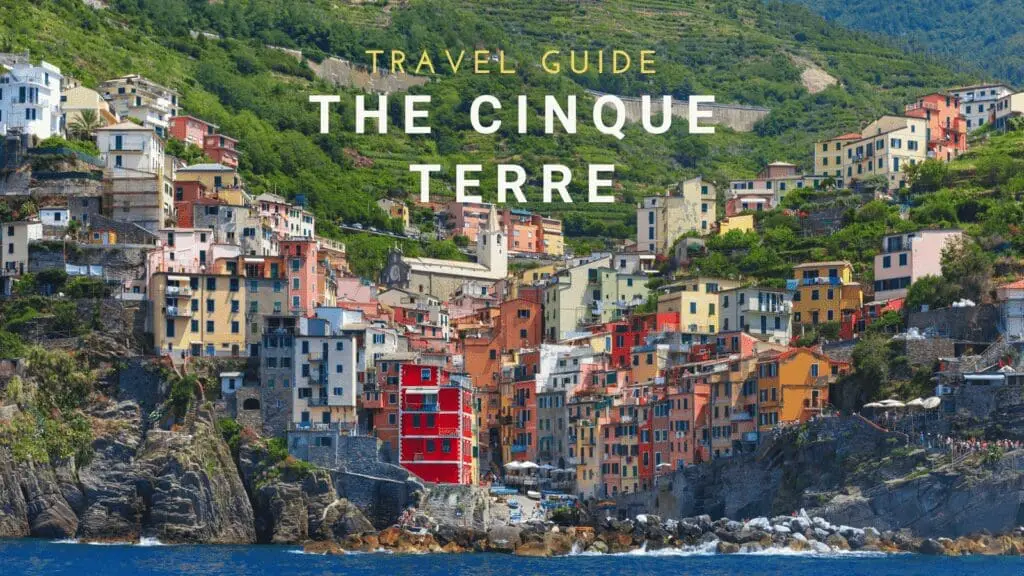
Getting To the Cinque Terre
I spent an entire afternoon and evening trying to figure out the best possible scenario for getting around the Cinque Terre and establishing a hotel home base.
From what I could discover, 2 options are more feasible and inviting (for travelers with sizable luggage and/or a car) than the rest: Portovenere & Monterosso al Mare.
These two larger port cities are basically the bookends to the Cinque Terre. Portovenere is closer to Florence and is located between La Spezia (Italy’s major naval base) and Riomaggiore. Monterosso al Mare, on the other hand, is located just the other side of Vernazza and is more difficult to access by car.
Both port cities offer larger hotels, better parking situations, and easy access to the smaller villages of the Cinque Terre via the ferries and/or train (although I do recommend the ferry if you are traveling in warmer months).
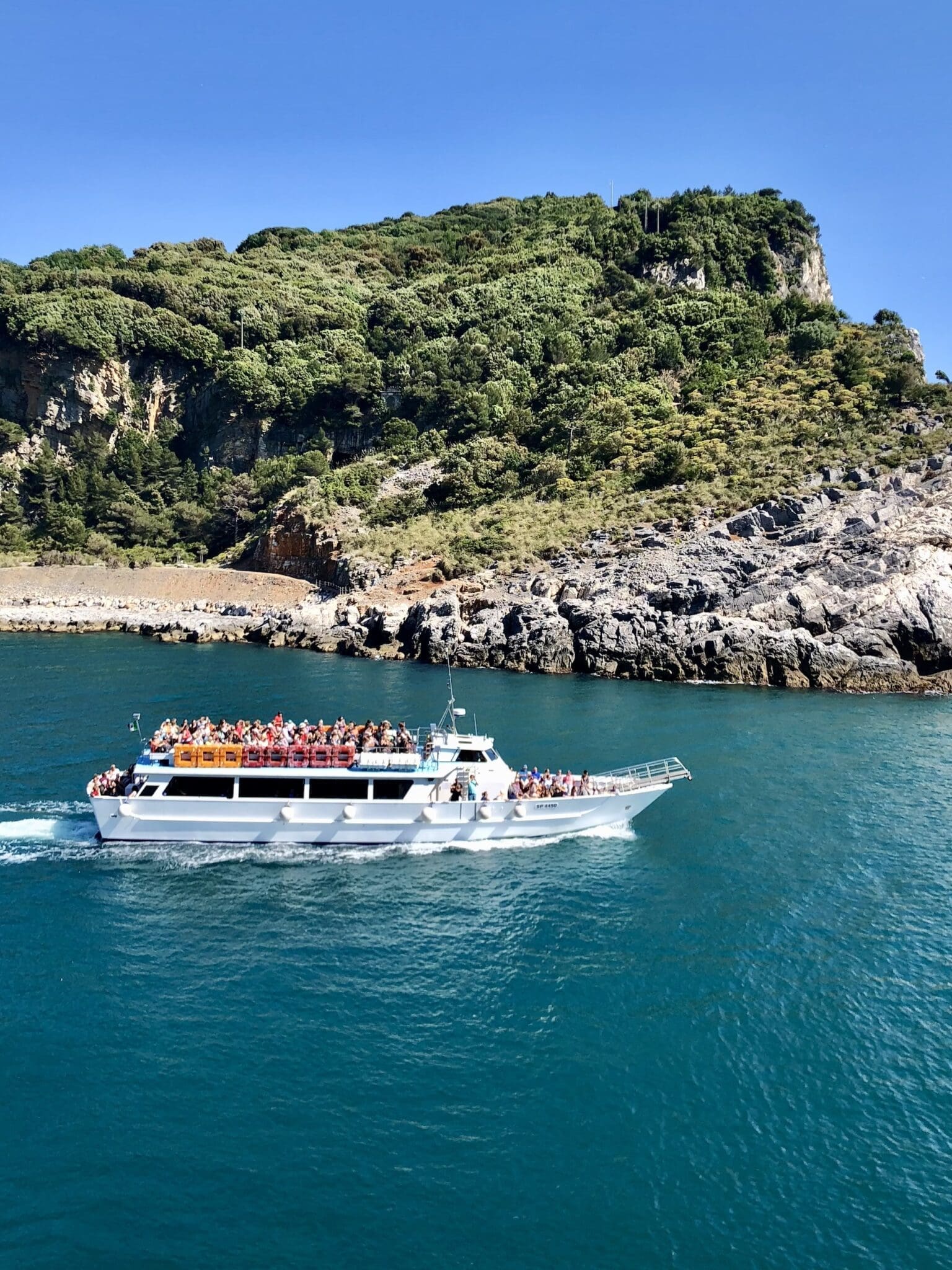
While both transportation options can be hot and crowded, at least the sea offers a breeze. The train, at least in my experience, had no air conditioning to speak of.
If you enjoy a more traditional beach town experience with an umbrella service, I suggest staying in Monterosso al Mare.
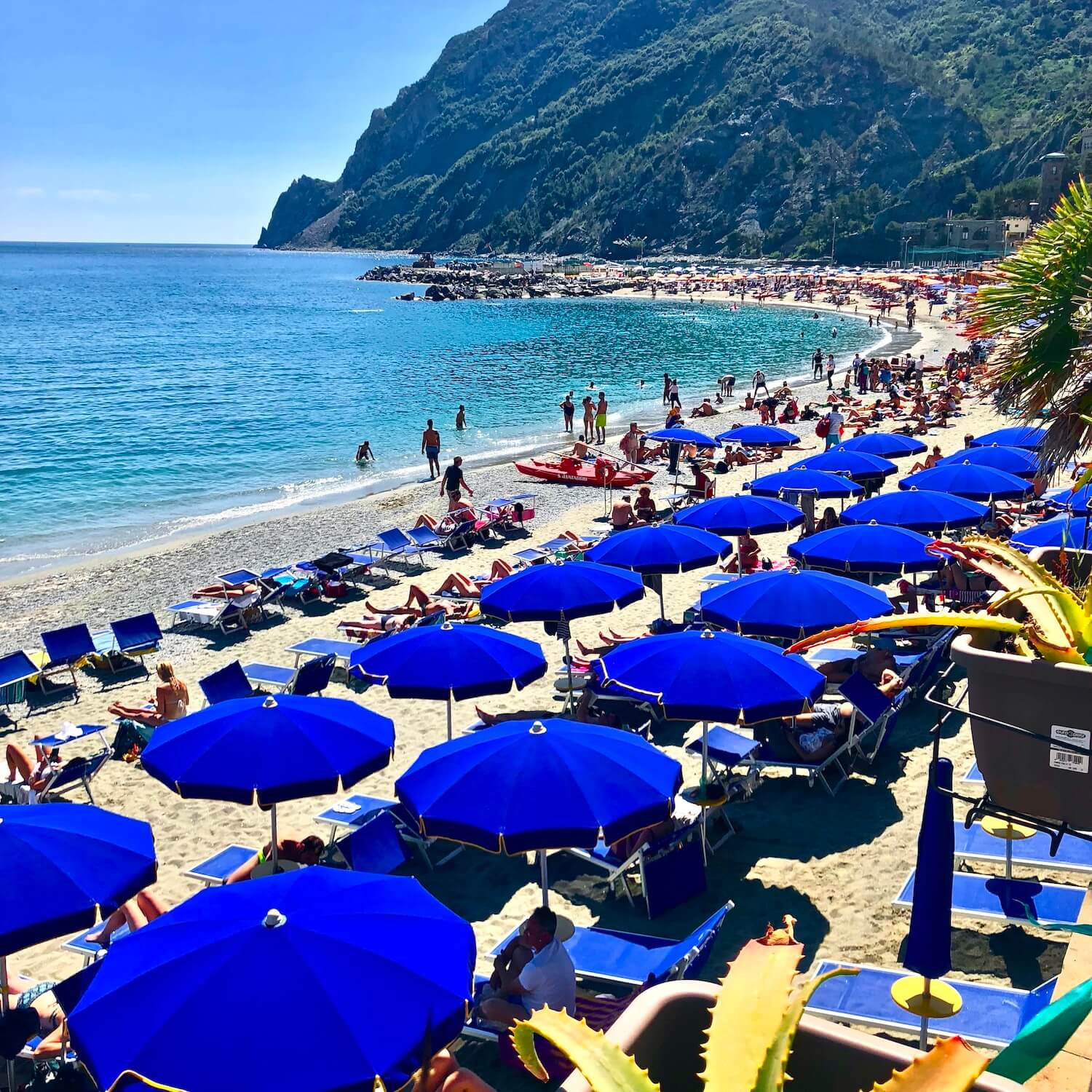
If you want more history and architecture combined with a rugged, rocky coastline, go for a Portovenere hotel.
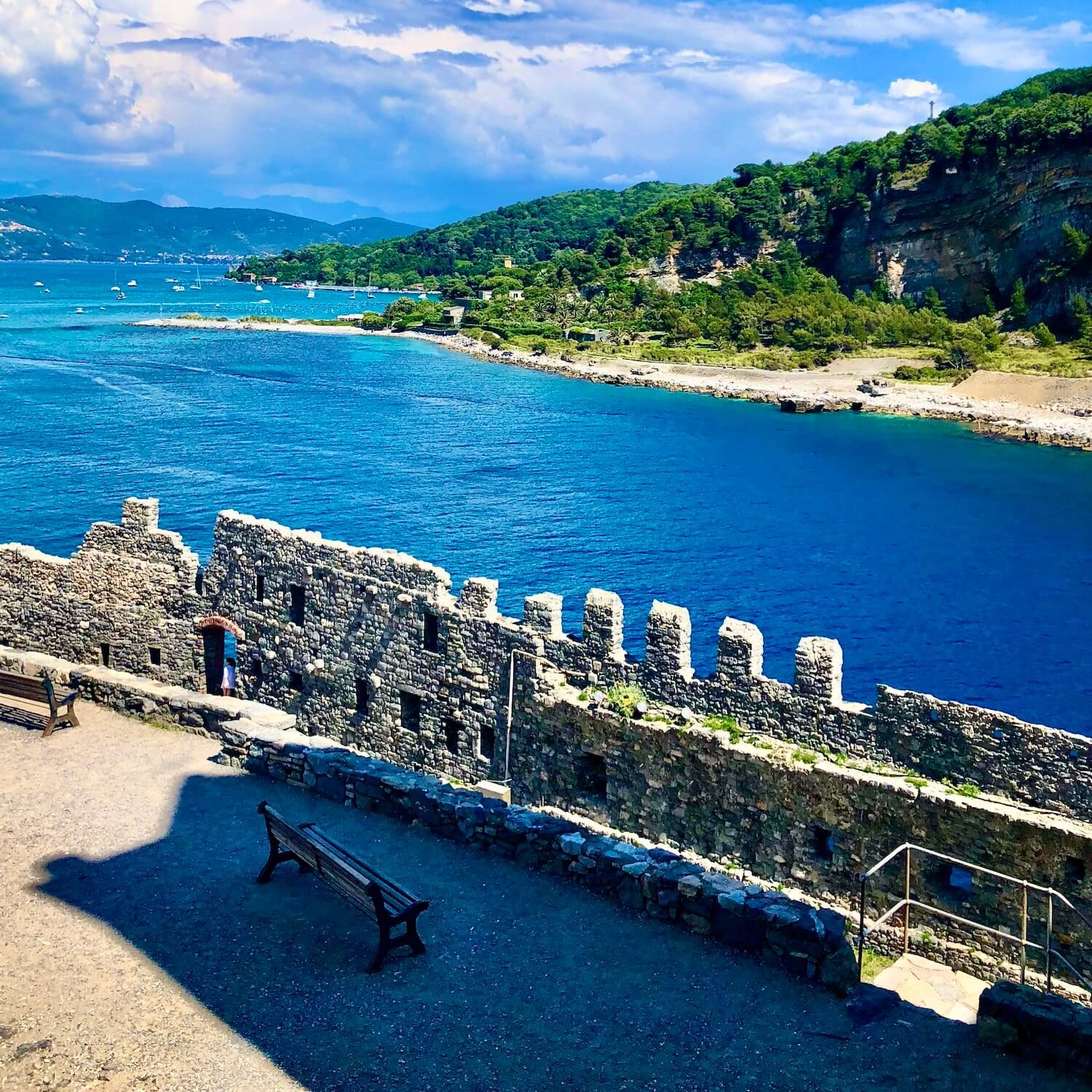
Whichever home base you choose, you will have close and relatively easy access to the smaller port towns — Riomaggiore, Manarola, Corniglia, & Vernazza.
If you plan to drive to the Cinque Terre from the Florence area to La Spezia, it makes sense to stay in Portovenere.
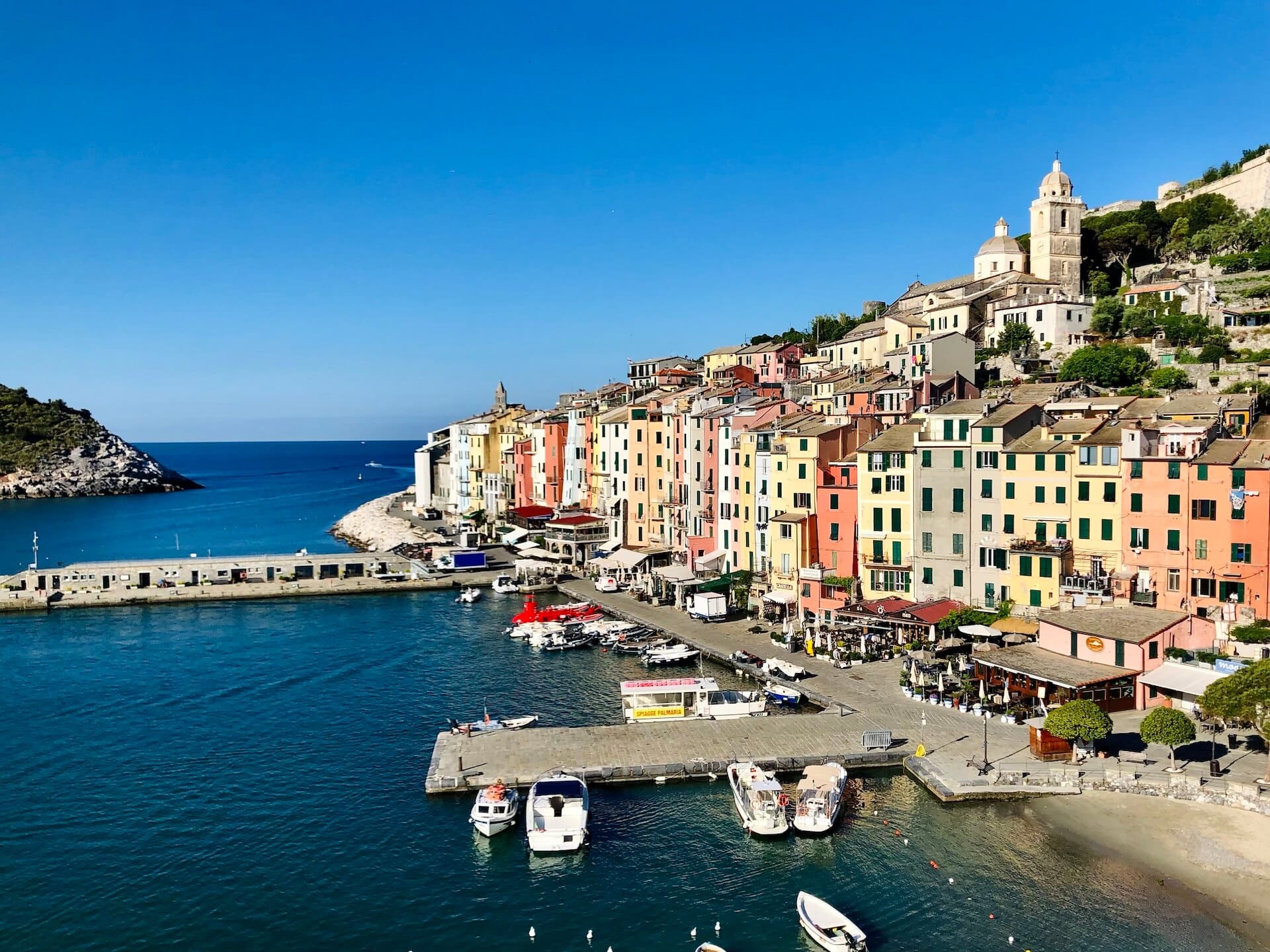
Staying in Portovenere
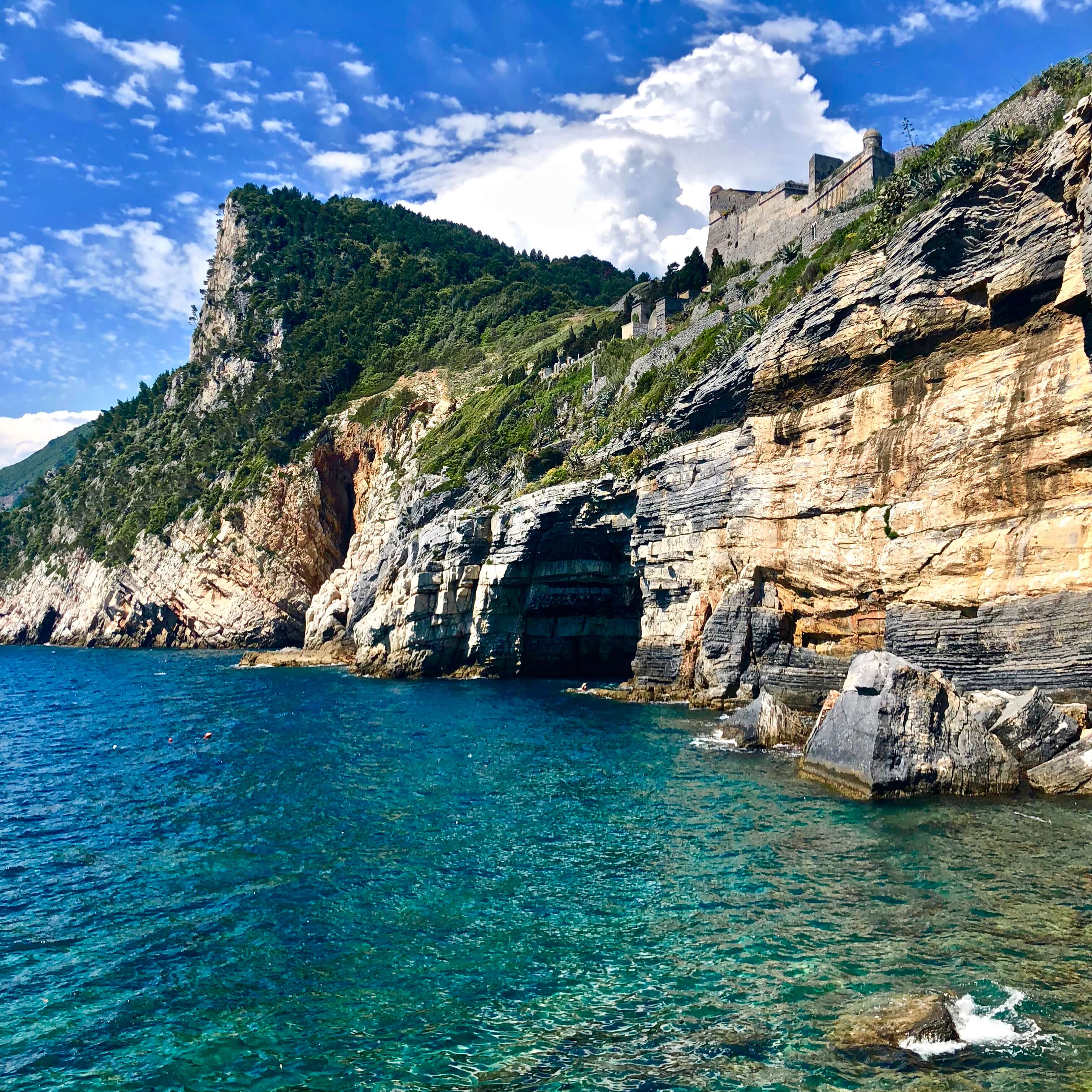
In Portovenere, everyone seems to be in love. It is, after all, the “Port of Venus.”
Although there are a couple of myths surrounding the origin of the village’s name, the most popular story goes that the goddess, Venus, was born from the sea foam surging below the Promontory of Punta San Pietro.
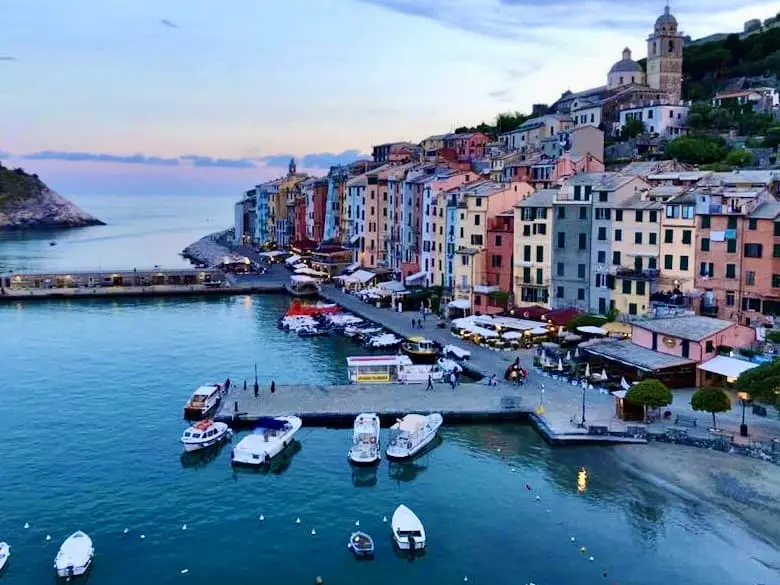
A temple was built and dedicated to the goddess, and the small seaside village took the name Portus Veneris. As is so often the case, the pagan temple to Venus was converted to a church between the 5th and 13th centuries and now stands as St. Peter’s Church.
If dedicating the village to the goddess of love wasn’t romantic enough, the area is also known as “The Gulf of Poets.” The area became a literary “hotspot” for writers and poets such as Percy Bysshe Shelley, his wife Mary Shelley, and Lord Byron. There is even a grotto dedicated to Byron with a plaque that reads:
“This grotto was the inspiration of Lord Byron. It records the immortal poet who as a daring swimmer defied the waves of the sea from Portovenere to Lerici.”
The Grand Hotel Portovenere
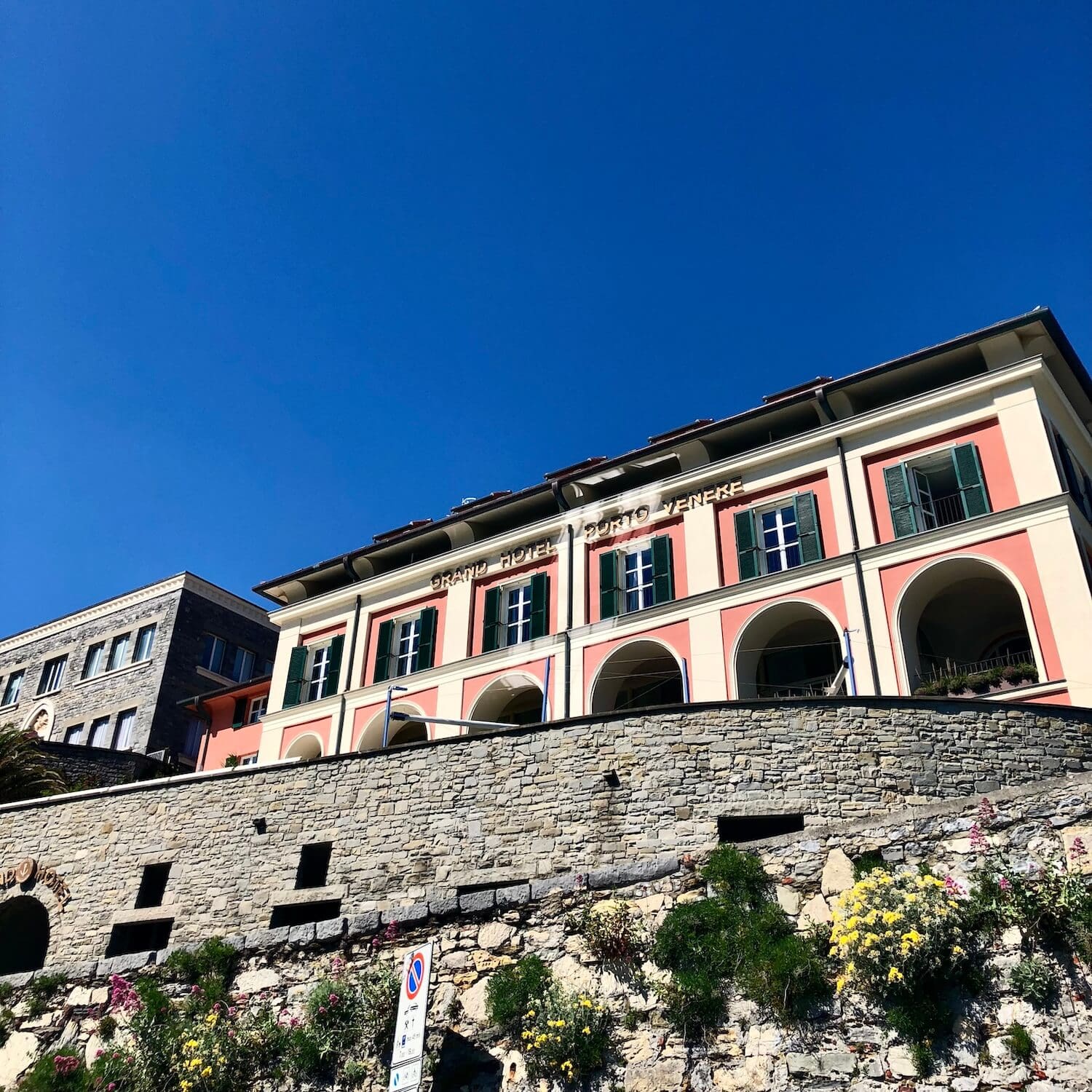
The 5 star Grand Hotel Portovenere is centrally located with crystal clear views of the harbor and the town center below.
Most rooms have sea views with balconies (except for the “Double Classic” rooms which offer interior courtyard views). If you are traveling to the hotel in your own car, you can park for free in their deck, provided you book directly through the hotel website.
A continental breakfast is served every morning in the Palmaria restaurant, extending its service to the sea terrace where the aperitivo happy hour is offered pre-dinner.

Palmaria shifts to a fine dining atmosphere in the evenings with a menu offering an upscale yet traditional combination of “land and sea” entrees.
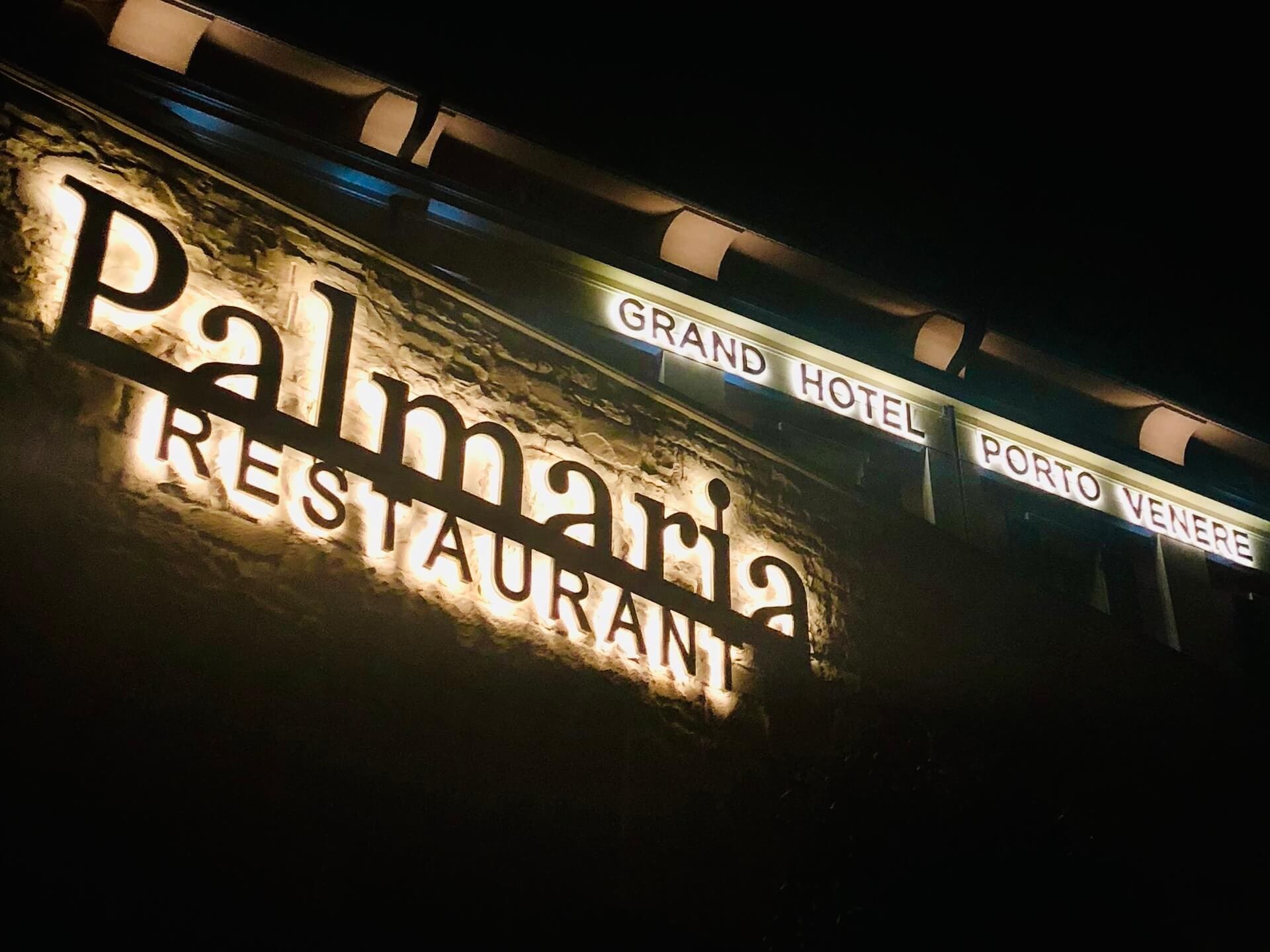
Dining in Portovenere
What’s on the menu in Portovenere and the rest of the Cinque Terre? Mainly fresh seafood and Trofie Pesto Pasta.
There’s not exactly a wide variation from menu to menu, but some restaurants do a much better job than others. Here are a few of my favorites:
Dinner in Portovenere
La Chiglia: A 15-minute walk from the Grand Hotel Portovenere, this large restaurant is highly rated for good reason. Exceptional flavor and freshness, and it also seems to be a local favorite given that most people dining there were Italian.
Le Tre Torre: Elegant dining in the heart of Portovenere’s main square. While they are open for lunch, it can be difficult to get a table, so reserve ahead.
The restaurant is charming in the evenings when it is lit up in soft golden lights. The chef crafts the menu from locally sourced seafood and the freshest ingredients.
La Medusa: Simple yet fresh located on the narrow street that runs behind the main waterfront thoroughfare.
Le Bucche: A candlelit, romantic oasis situated at the tip of the rocky promontory overlooking the sea. The menu is also primarily seafood-based, but there are also a few vegetarian options. It’s the kind of place to sit and sip into the evening, listening to the water softly lapping the rocks.
Palmaria Restaurant: Whether you’re staying at the Grand Hotel Portovenere or elsewhere, this restaurant is consistently delicious and a great space for larger groups and wedding parties.
Lunch in Portovenere
La Marina da Antonio: Go for waterfront dining with views of the bustling harbor under the large canopy. The seafood paella is a specialty, and I enjoyed the pesto ravioli paired with a glass of prosecco.
Bistro La Piazetta: A charming spot for lunch tucked away amongst the shops. Need a break from all the seafood? Pop in for fresh caprese sandwiches, lasagnes, and, of course, pizzas. If the tiny dining room is full, there’s an adjacent courtyard with umbrella tables.
Cocktails & Aperitivo in Portovenere
The Venus Bar: Also located at the Grand Hotel Portovenere, the Venus bar is “located under the high-vaulted brick ceilings of the historic building that once hosted the San Francis Convent.” The bar itself is lovely, but you’ll want to sit outside on the terrace to enjoy the elevated views of the sea and harbor. They offer classic cocktails with modern innovations as well as an extensive wine list.
Portovenere Attractions
Church of St Peter | Chiesa San Pietro
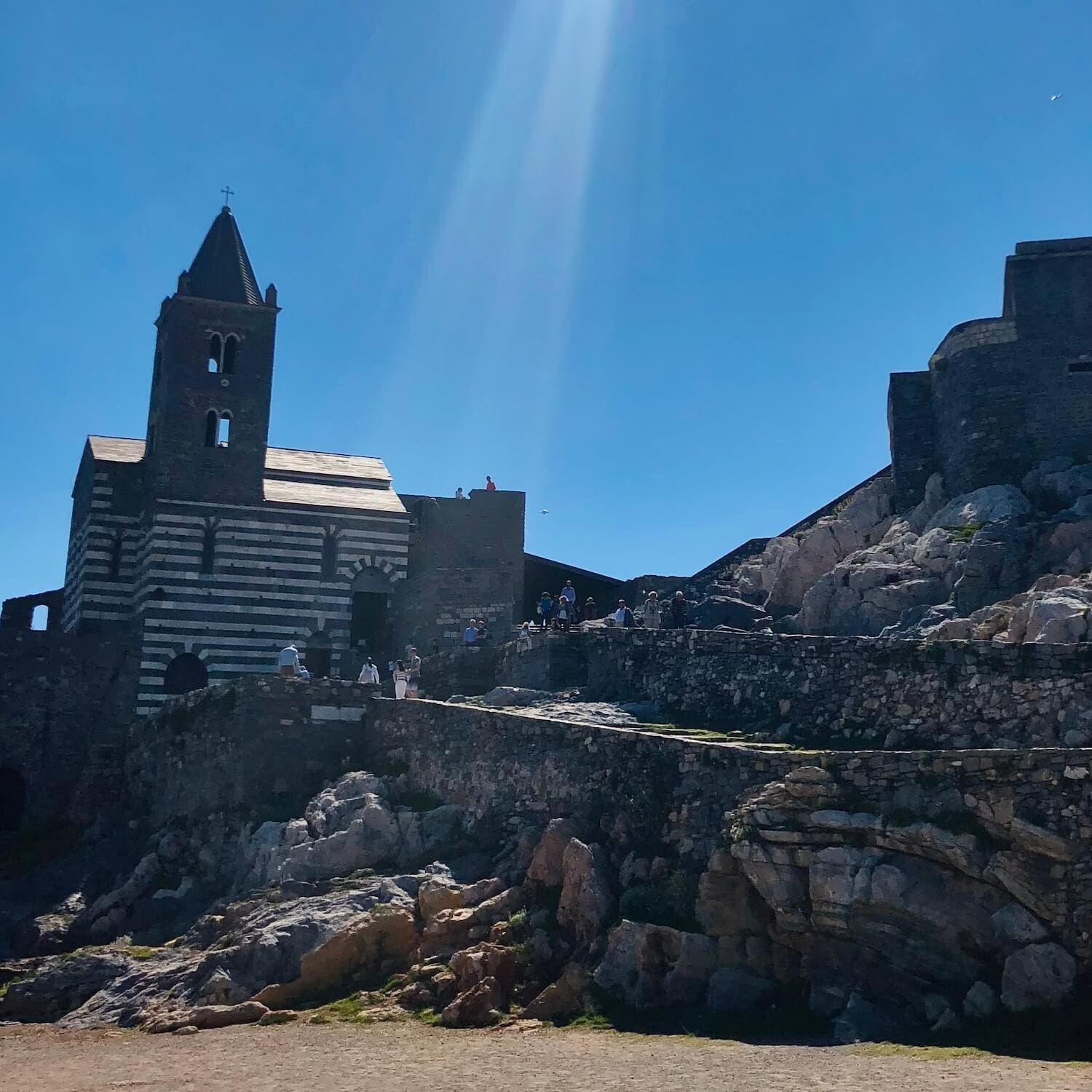
The Church of St Peter was officially consecrated in 1198. Entry is free, and to get there, walk along the waterfront, past “Byron’s Grotto” to the right, and proceed up the large (and FYI, sometimes slippery) steps.
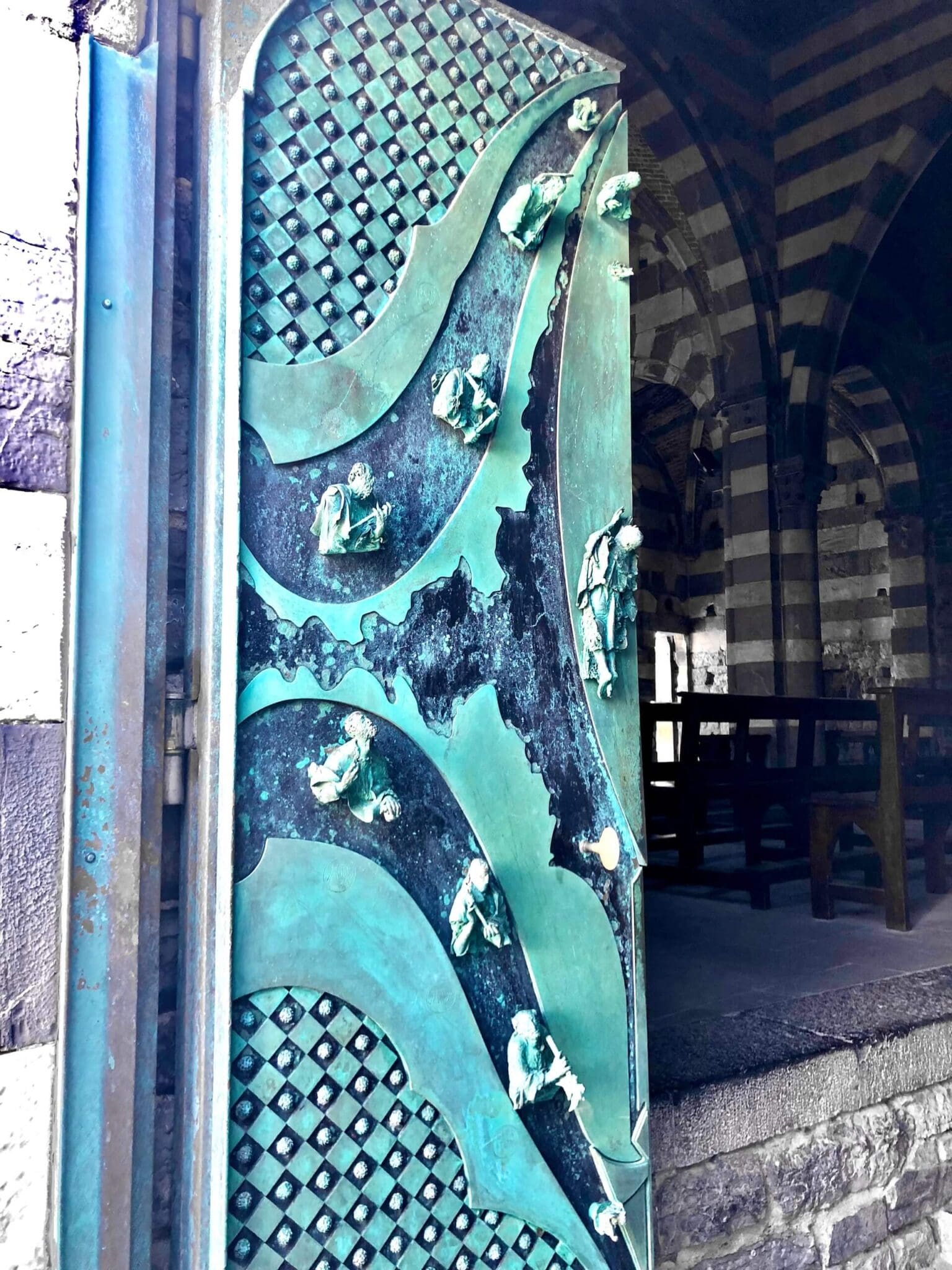
It’s not a very large structure and can be crowded at times, but it’s worth visiting. The black and white striped portion of the church dates back to the 13th century.
When you’ve finished touring the church, don’t miss the views from the open-air alcove to the right.
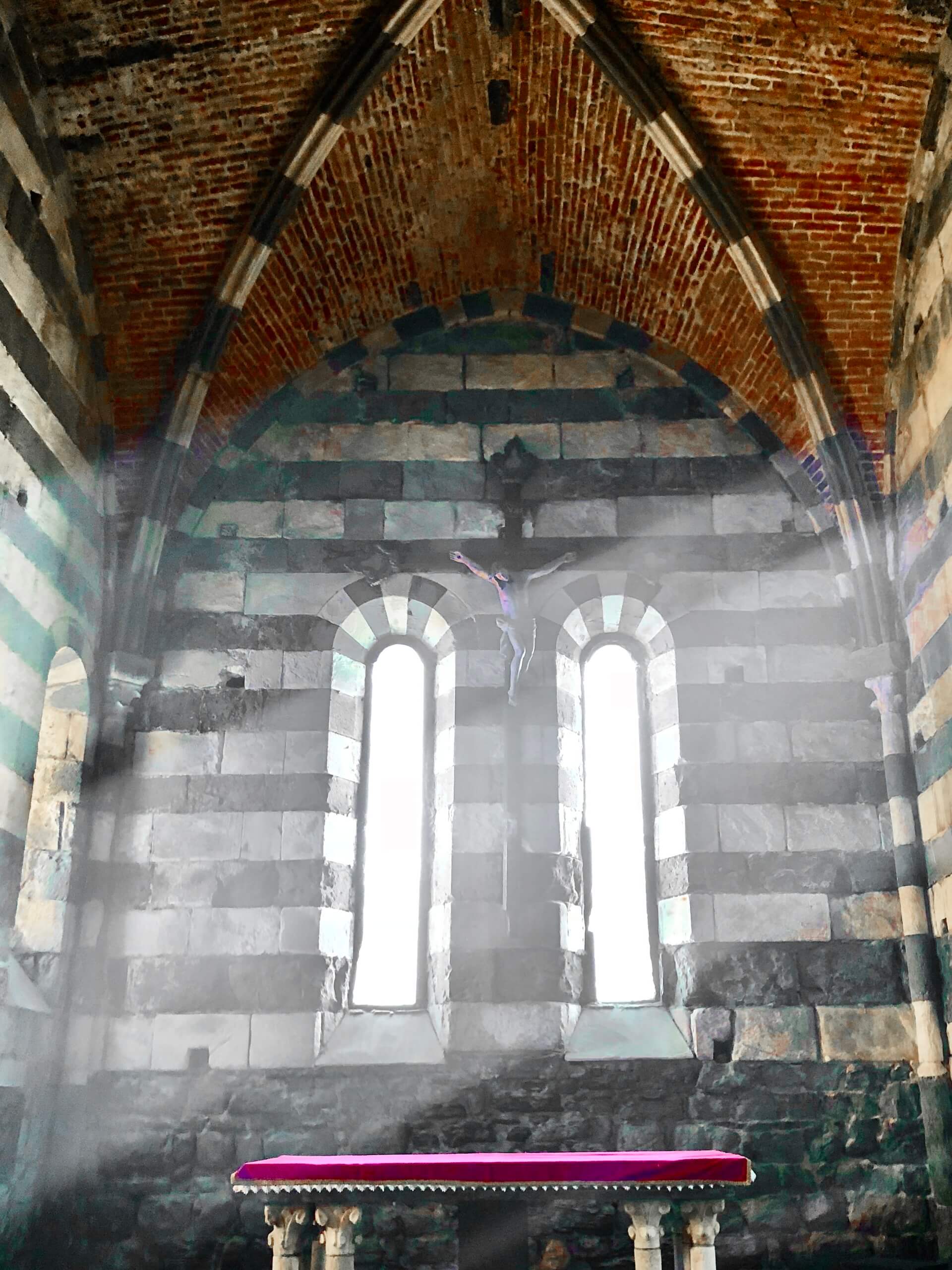
Castello Doria
Some of the best views to be had in Portovenere are at the Castello Doria. While it’s a climb to get to the top, it’s worth every step.
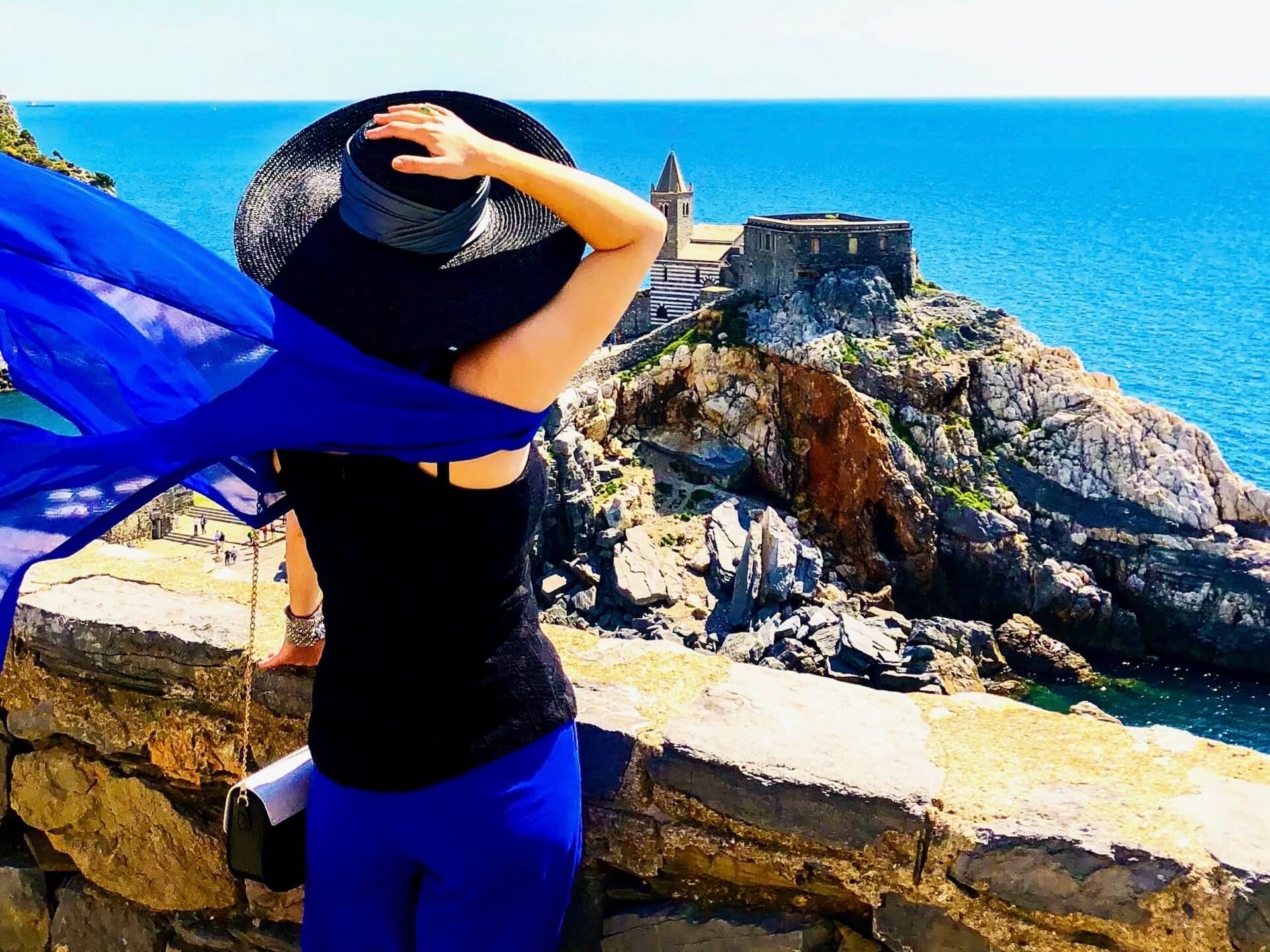
Although it’s unclear exactly when initial construction began on the castello, historical documents mention the structure in 1139 when the Republic of Genoa took over Portovenere.
The castle has primarily been used as a military base throughout the ages, but it was used as a prison during Napoleon’s reign.
General Admission tickets are 5 euros to enter.
Riomaggiore
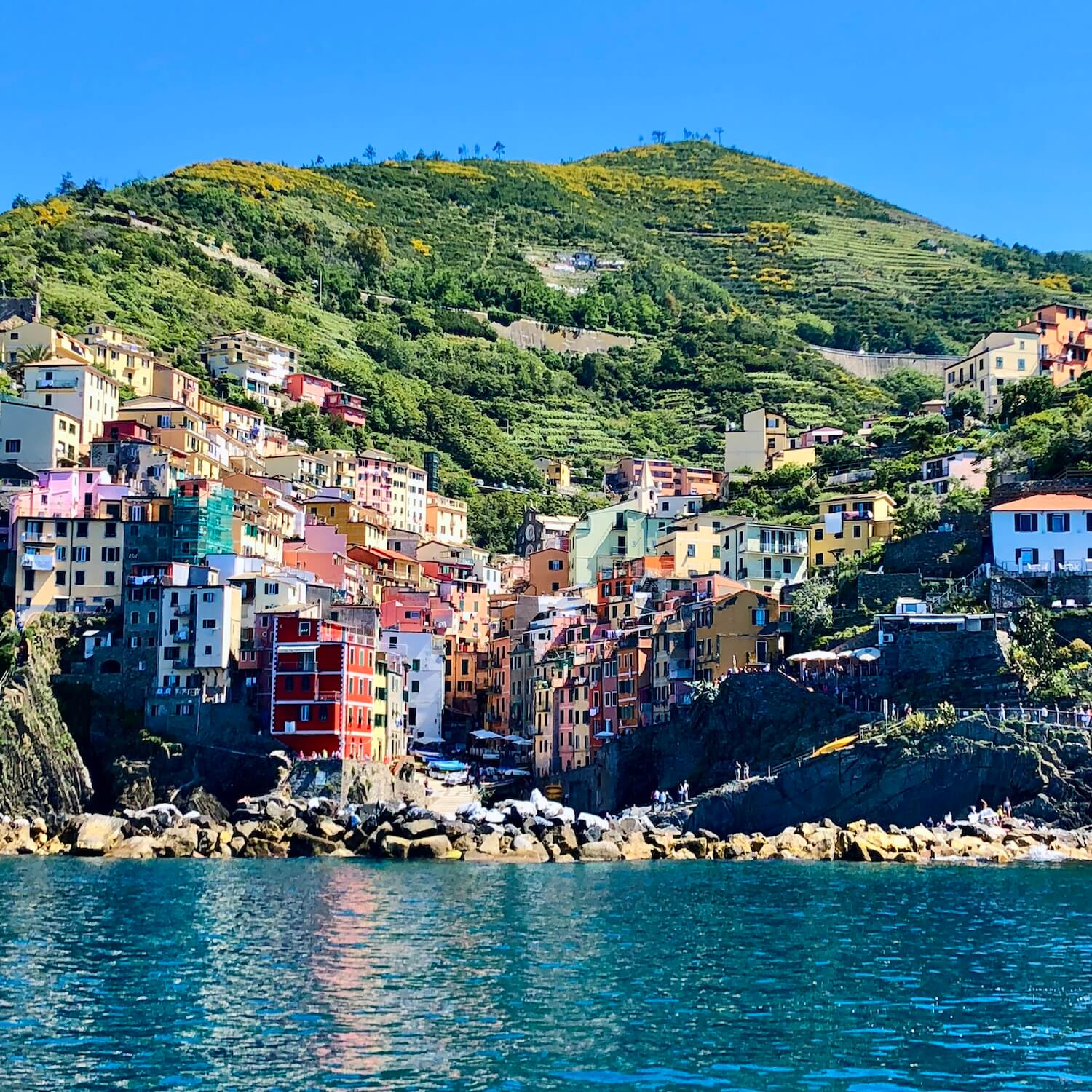
Riomaggiore is the easternmost village of “The Five Lands” (Cinque Terre) and is easily accessed from Portovenere via the ferry. Built into the steep cliffside, the town design looks like a sloping, terraced V.
The main street through the village begins as the Via San Giacomo and eventually melds into the Via Colombo. Along this way is where you’ll find the vast majority of Riomaggiore’s shops, cafes, and restaurants.
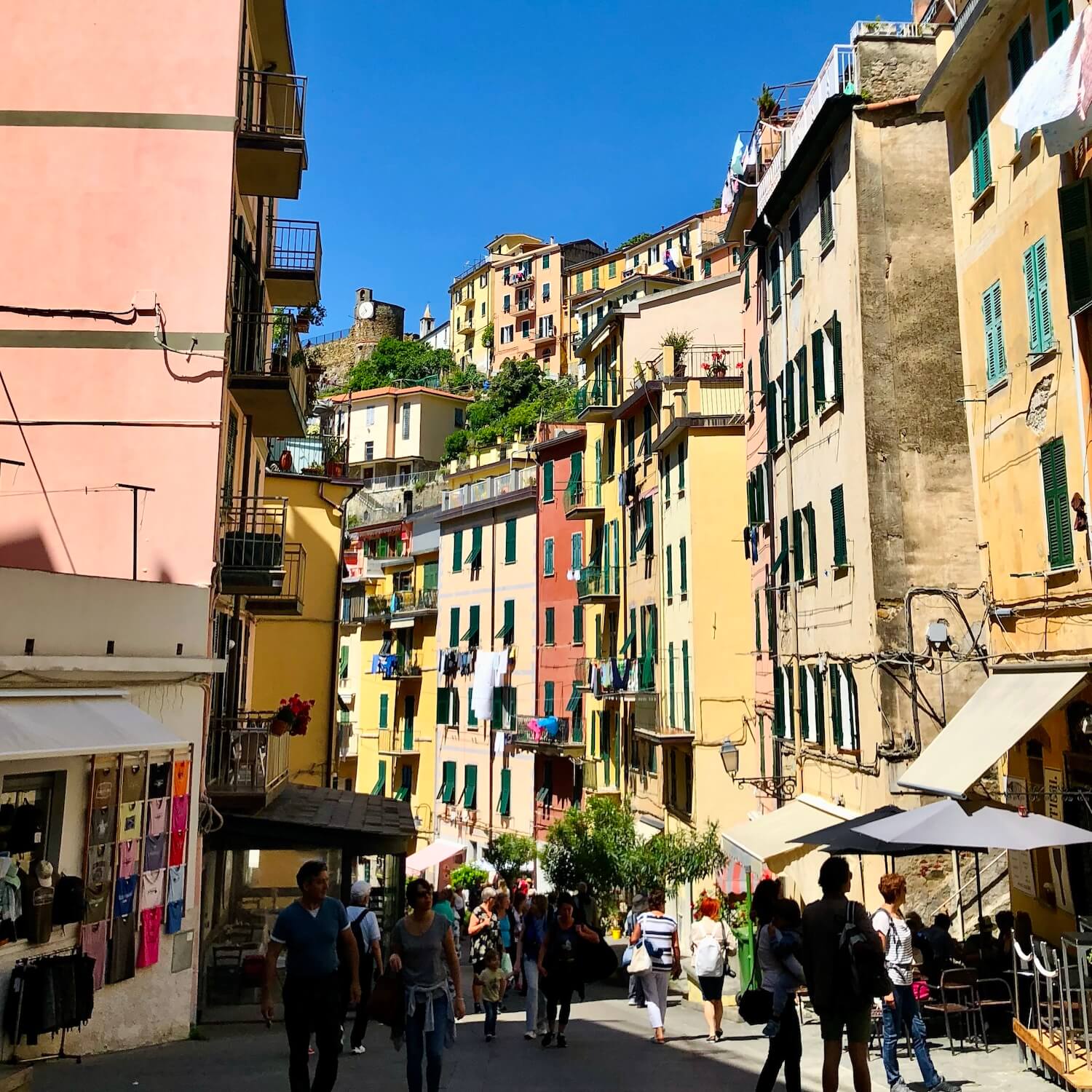
I found Riomaggiore to be quieter and less crowded than the other villages. At least it was while I was there in May.
While there is a nice assortment of lunch spots, we chose Il Grottino, centrally located along Riomaggiore’s main street. We ordered the Trofie di Pesto and the Ravioli Bolognese, which were both excellent.

I discovered there’s not much variation between the trofie pesto pastas along the Ligurian Coast, but Il Grottino’s was probably the best one I tasted.
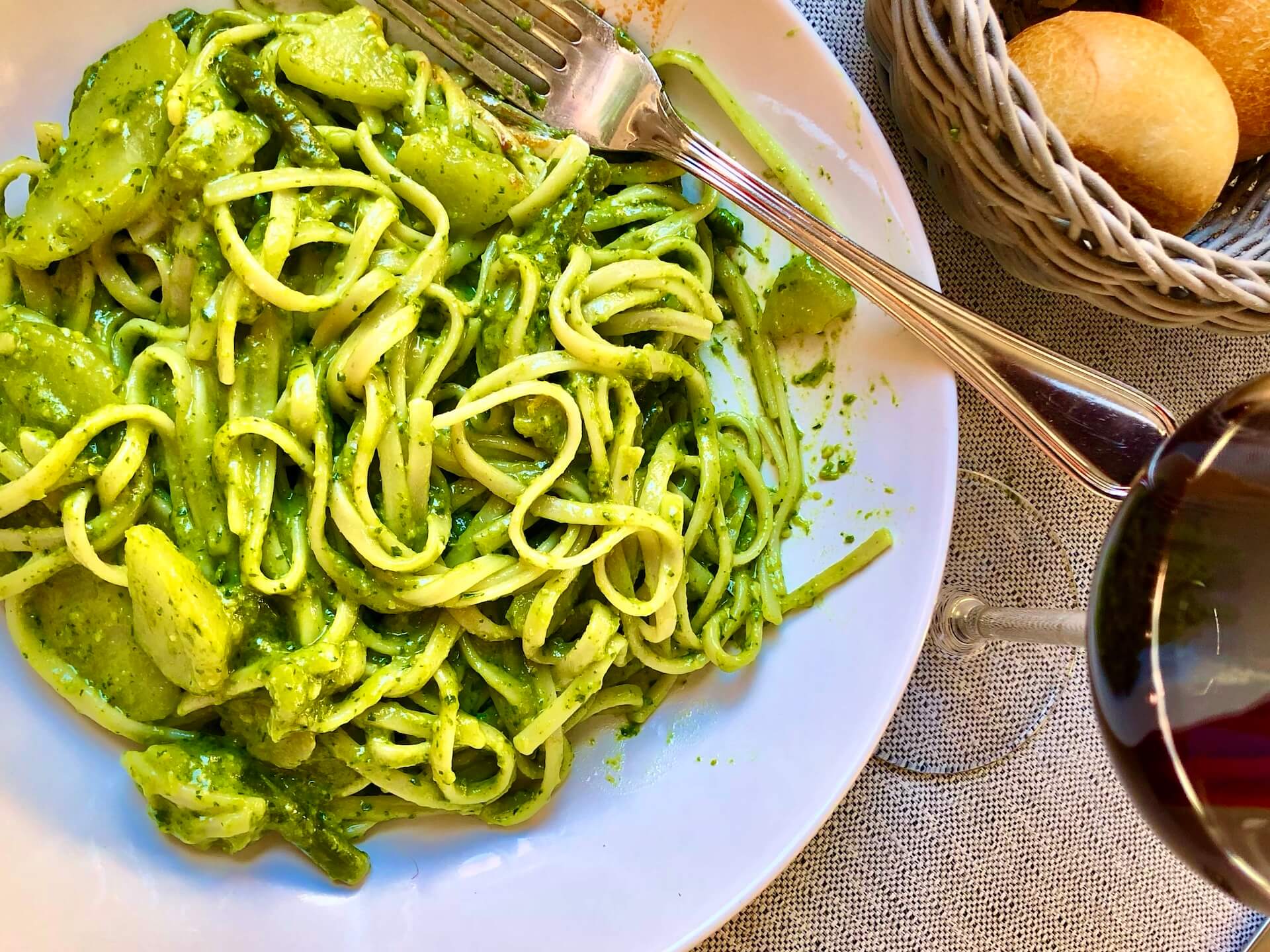
Riomaggiore is a lovely place to spend a few hours. Still, once you’ve walked the main thoroughfare and visited one of the 14th-century churches (San Giovanni Battista and San Lorenzo) or taken in the sea views from the Castle of Riomaggiore (built-in 1260), you’ll most likely be ready to move on to another town, the closest being Manarola.
Manarola

Getting to Manarola from Riomaggiore takes practically no time at all. So if you’re in a time crunch, take the train. You’ll be there before you can even settle into a seat.
If you time the ferry right, that’s also a good option, although you want to make sure they are stopping at Manarola and not heading straight on to Monterosso al Mare or some other town.
Unfortunately, the Via dell’Amore (the walking path that connects the two towns) is currently closed and has been for some years apparently.
Nevertheless, there are still loads of hikers trekking back and forth across the Cinque Terre, but be sure to check ahead of time for any path closings if you’re looking to hike the scenic trails.
Manarola doesn’t have a beach, but the rocky cove is beautiful with its clear emerald pools.
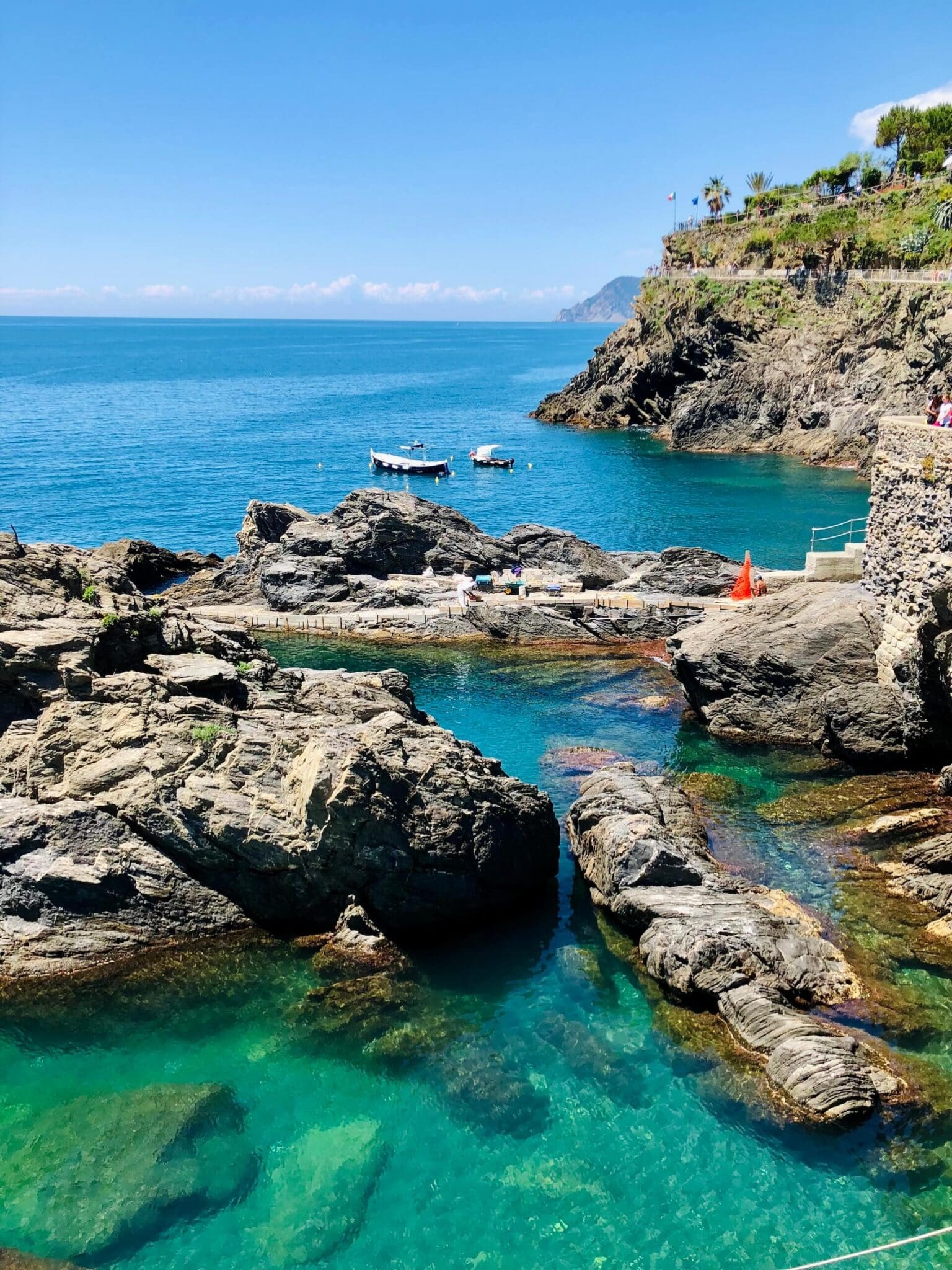
Along this path is a lovely restaurant and cantina called Nessun Dorma, and if you get a chance, definitely eat here.
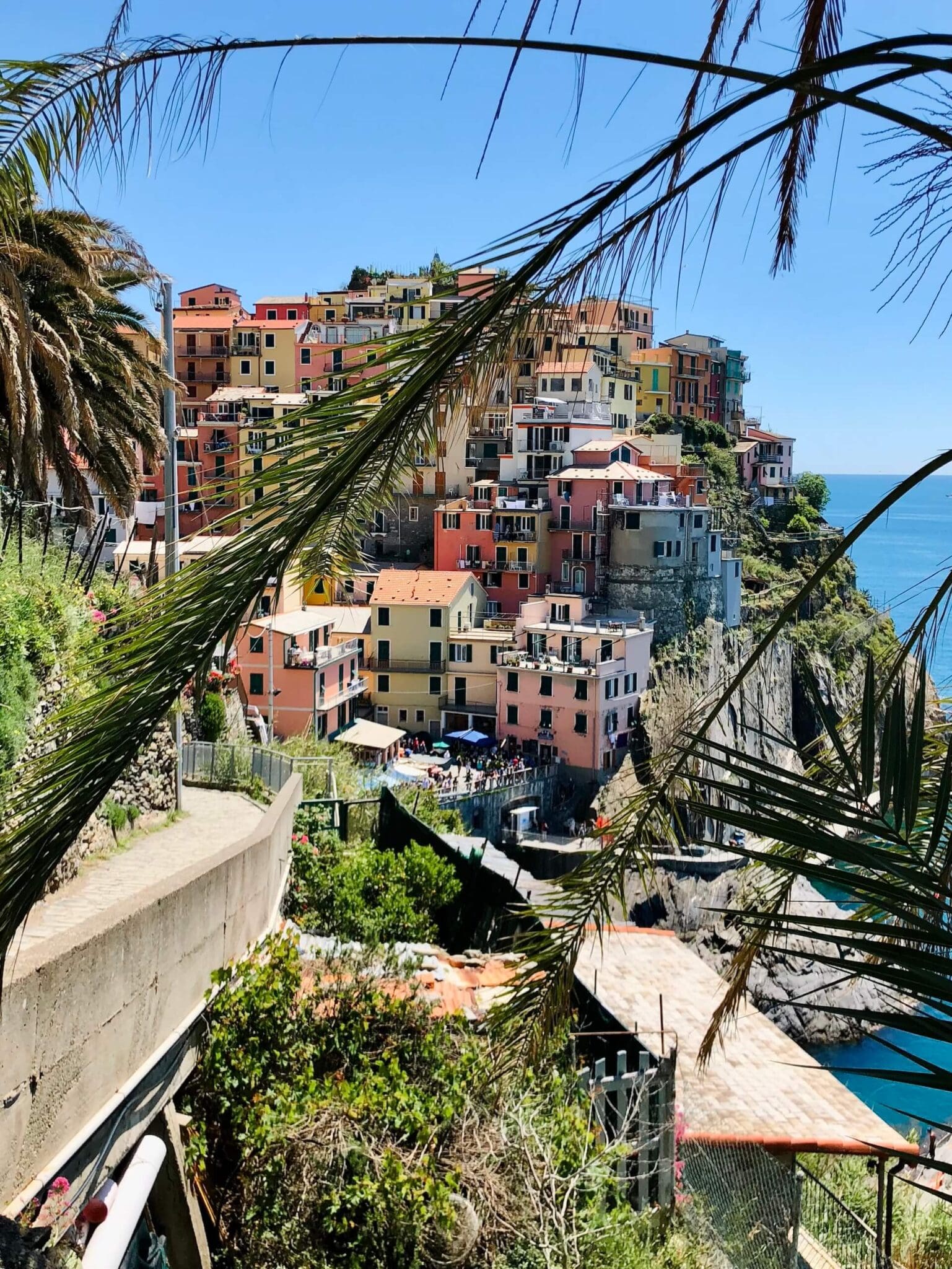
Creamy white umbrellas line the rock terrace where you can dine with unlimited views of the sea and village of Manarola below.
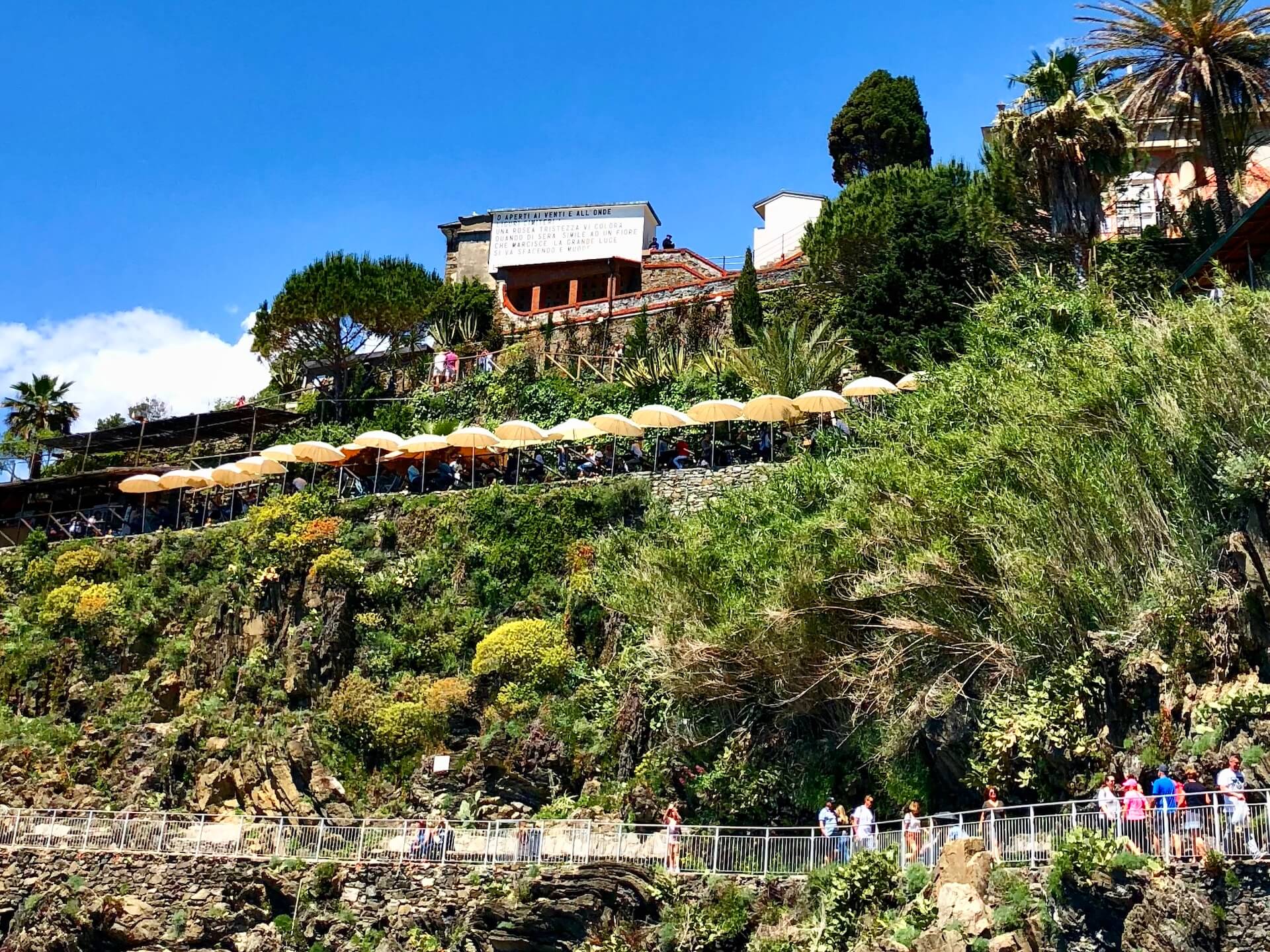
Due to its popularity, scoring a table may be difficult, but not to worry. The bustling piazza of Manarola is full of bars and cafes where you can stop for a refreshment.

Manarola is fairly similar to Riomaggiore in that you’ll find most shops and restaurants along its main thoroughfare. However, I do recommend walking the path along the cliff ridge to the scenic viewpoint.
The path connects to the Via di Corniglia which is the connecting hike to the village of Corniglia, the middle town of the Cinque Terre perched high above sea level with a population of less than 300. This path was also closed due to a landslide but was being rebuilt.
If you continue up the path past Nessun Dorma, you’ll discover the Cemetery of Manarola. It’s a peaceful place, with flowers adorning the graves, and unobstructed views of the sea stretching out below.
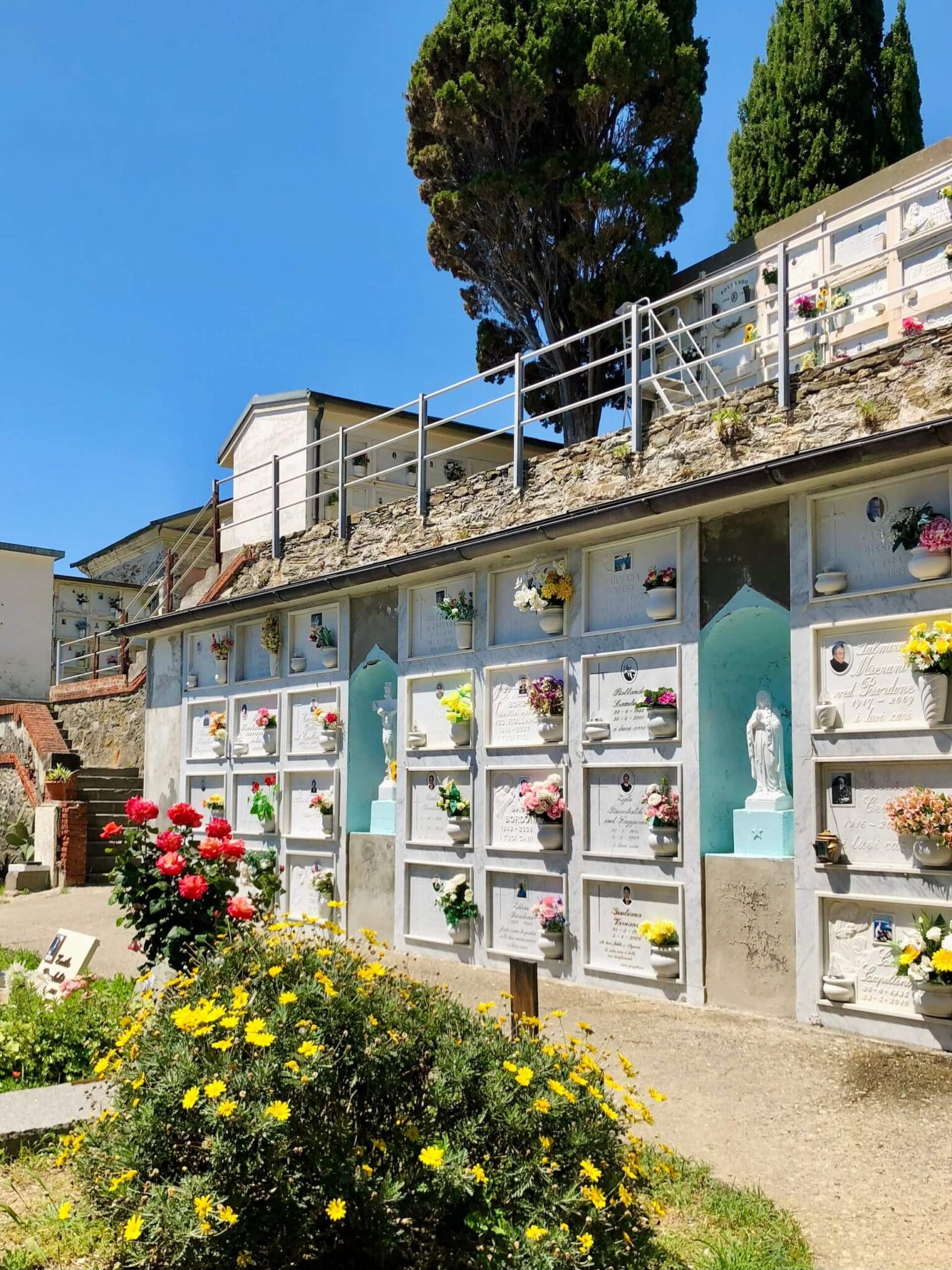
Vernazza
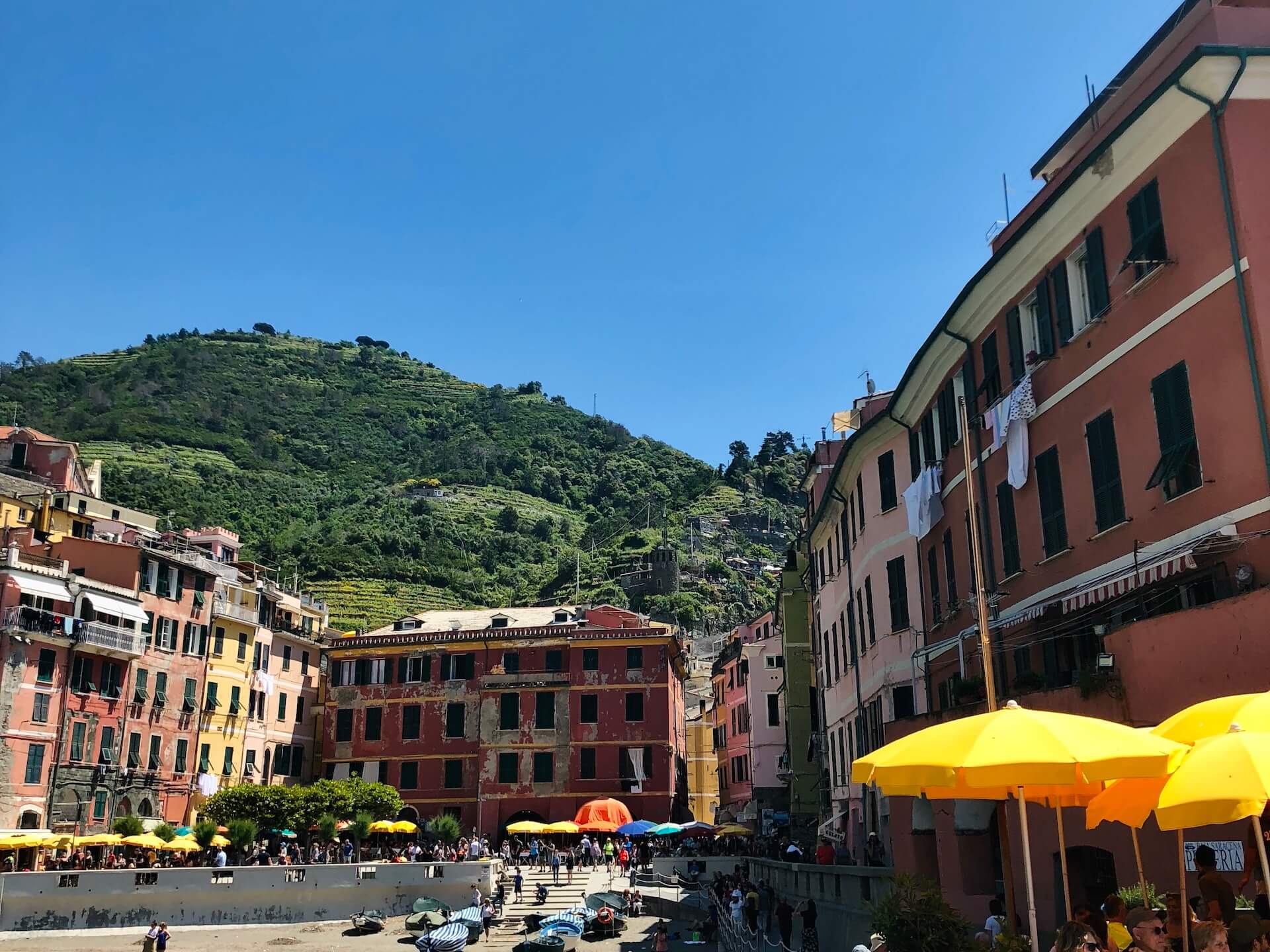
After stepping off the ferry into Vernazza’s main square, you might feel a little overwhelmed by the crowds. This village, too, is beyond picturesque with its natural harbor filled with bobbing boats and streets lined with sunny yellow umbrellas, but every establishment seems to be overflowing with people.
Walking along the Via Visconti and onto the Via Roma, you’ll see several ice cream shops and pizzerias, each more delectable than the rest, but the lines of people can spill out onto the narrow street.
My suggestion? Leave the main thoroughfares and start climbing towards La Torre Bar, Restaurant, and Rooms. It’s quite the hike to get up there, and signs point the way upward and onward.
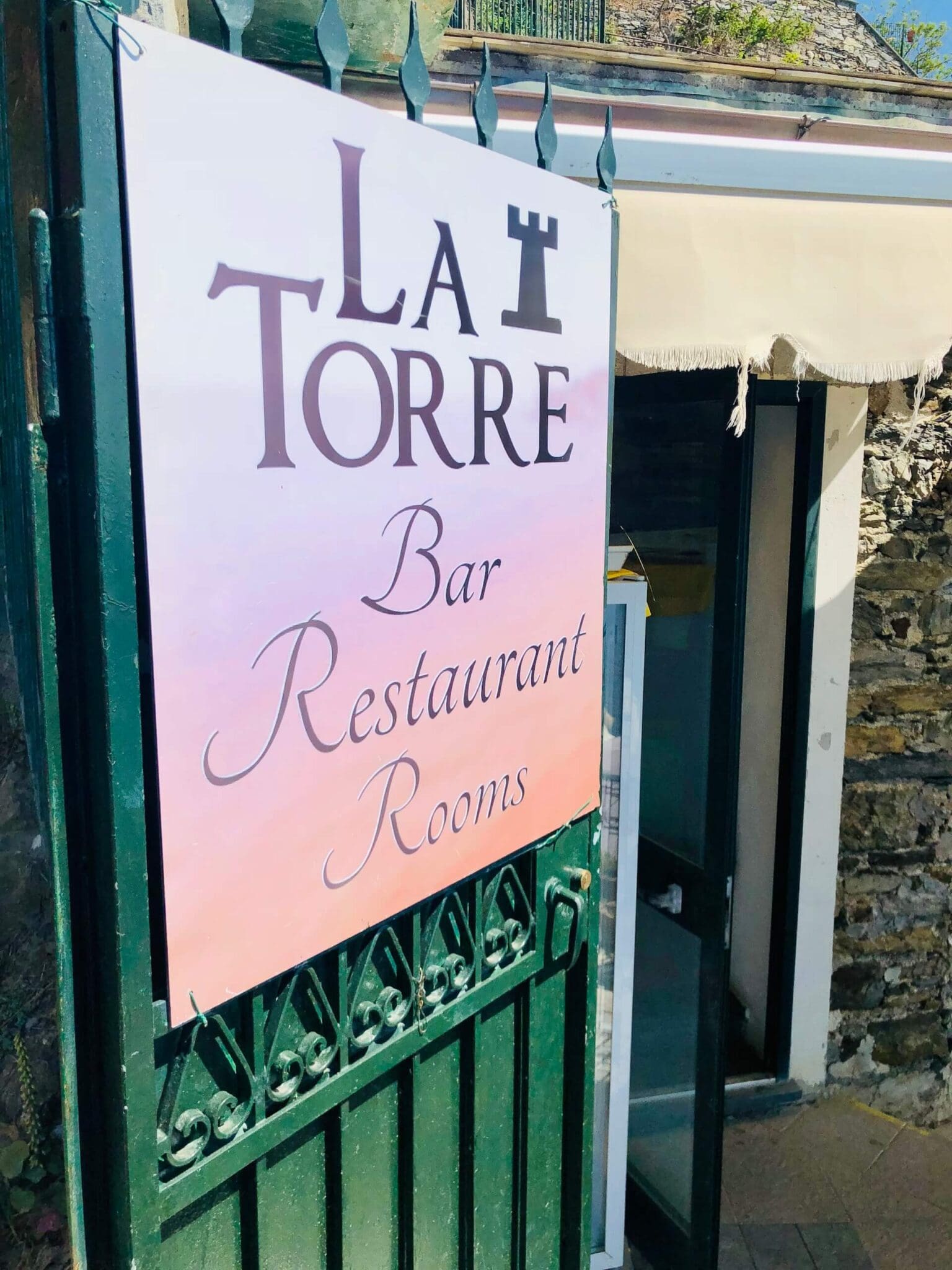
At times the signs pointing the way seem to taunt you rather than encourage you. “Only a few more meters…”
If you need to rest, you can pause along the way and lean against the low stone wall that lines the path up to La Torre.
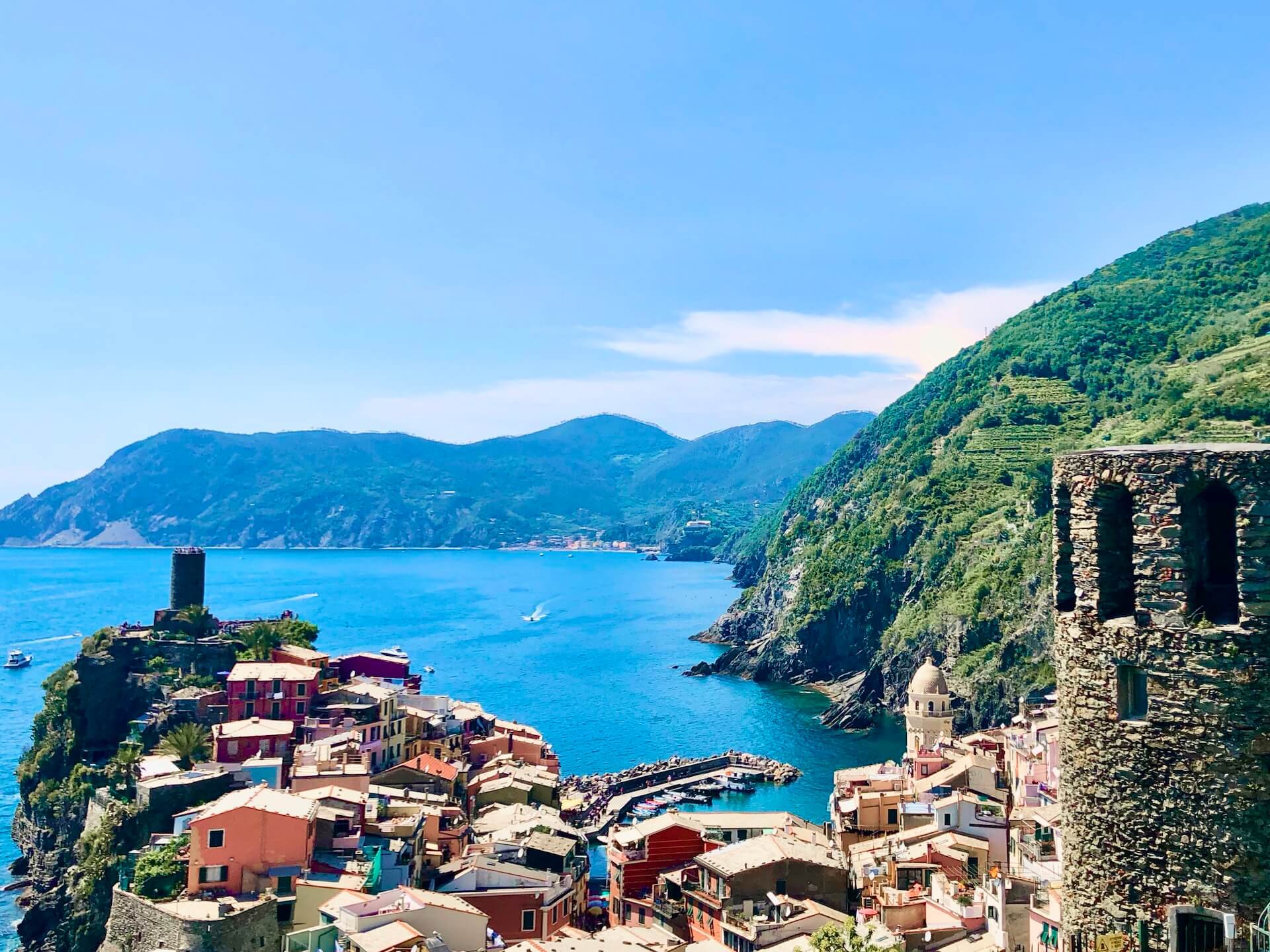
Maybe it was the altitude, the view, or the effort it took to get there, but lunch at Le Torre was probably my favorite of my entire stay in the Cinque Terre.
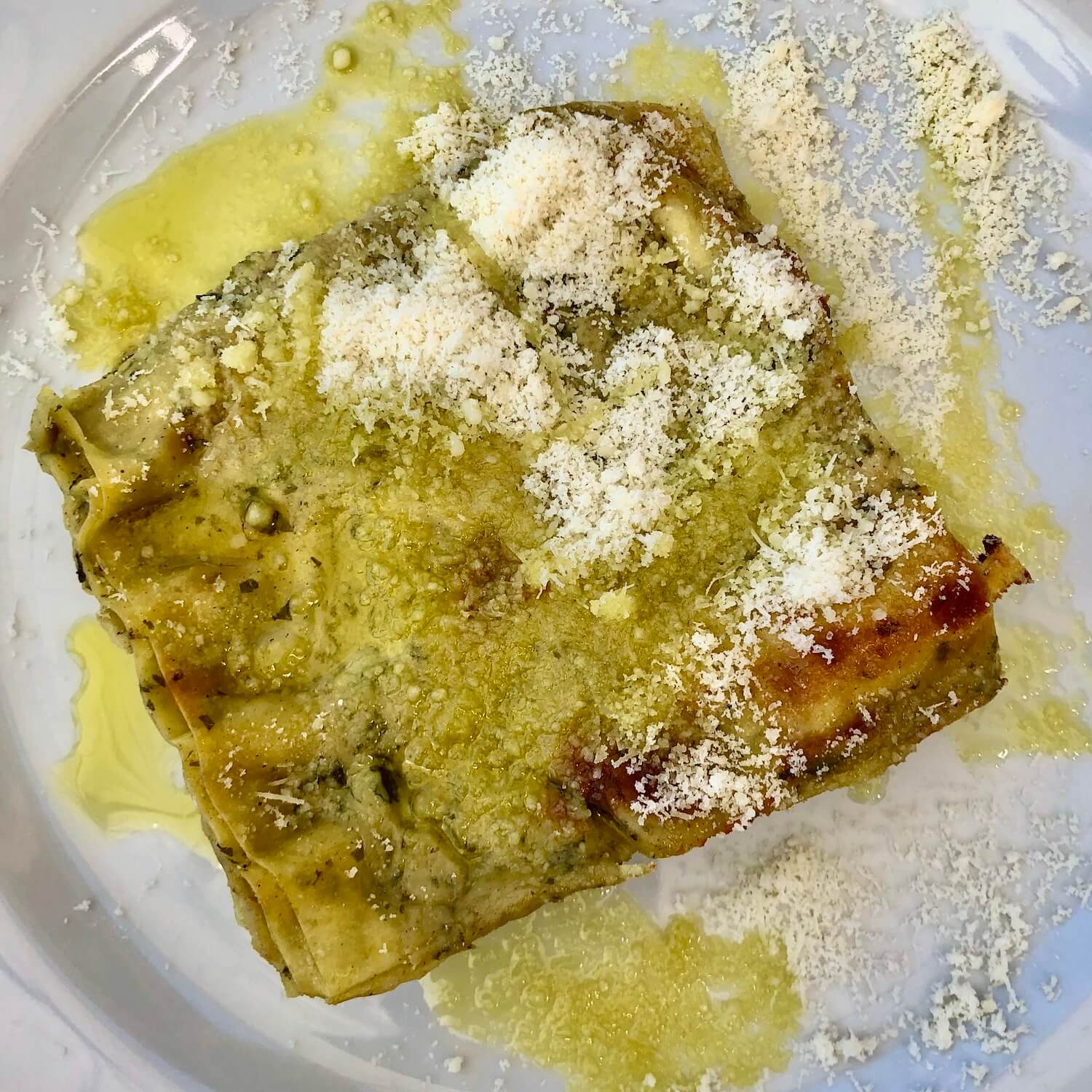
We sampled two lasagnas, and the layers of hand-made noodles were so thin they melted like butter with every bite. We ordered a bottle of local red wine: Serro de’Becchi Rossese di Dolceacqua Superiore 2014.

Monterosso Al Mare
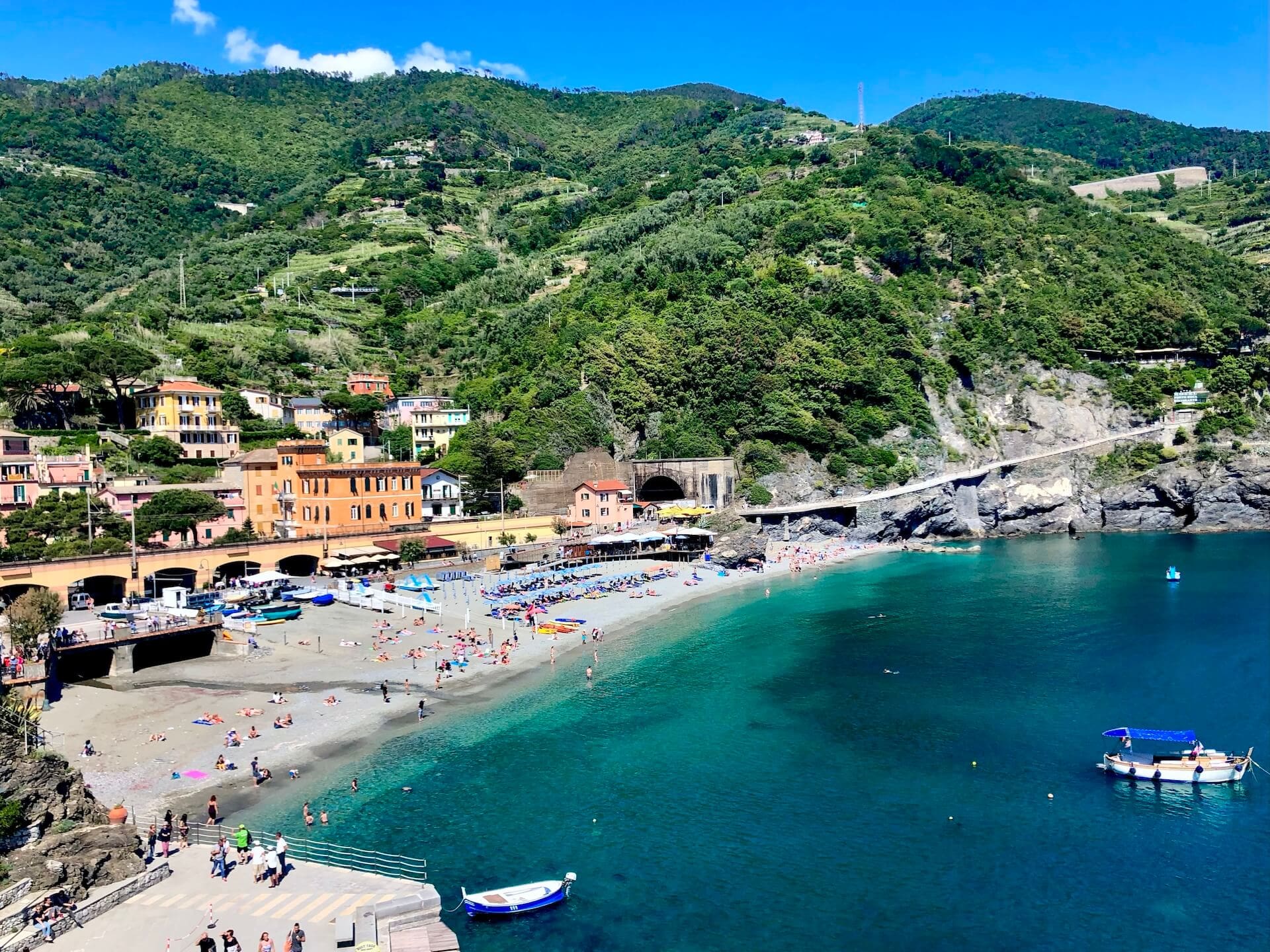
If we hadn’t stayed in Portovenere, I think I would have liked to stay in Monterosso al Mare. With its traditional beaches and larger town center, it’s a lovely village to explore.
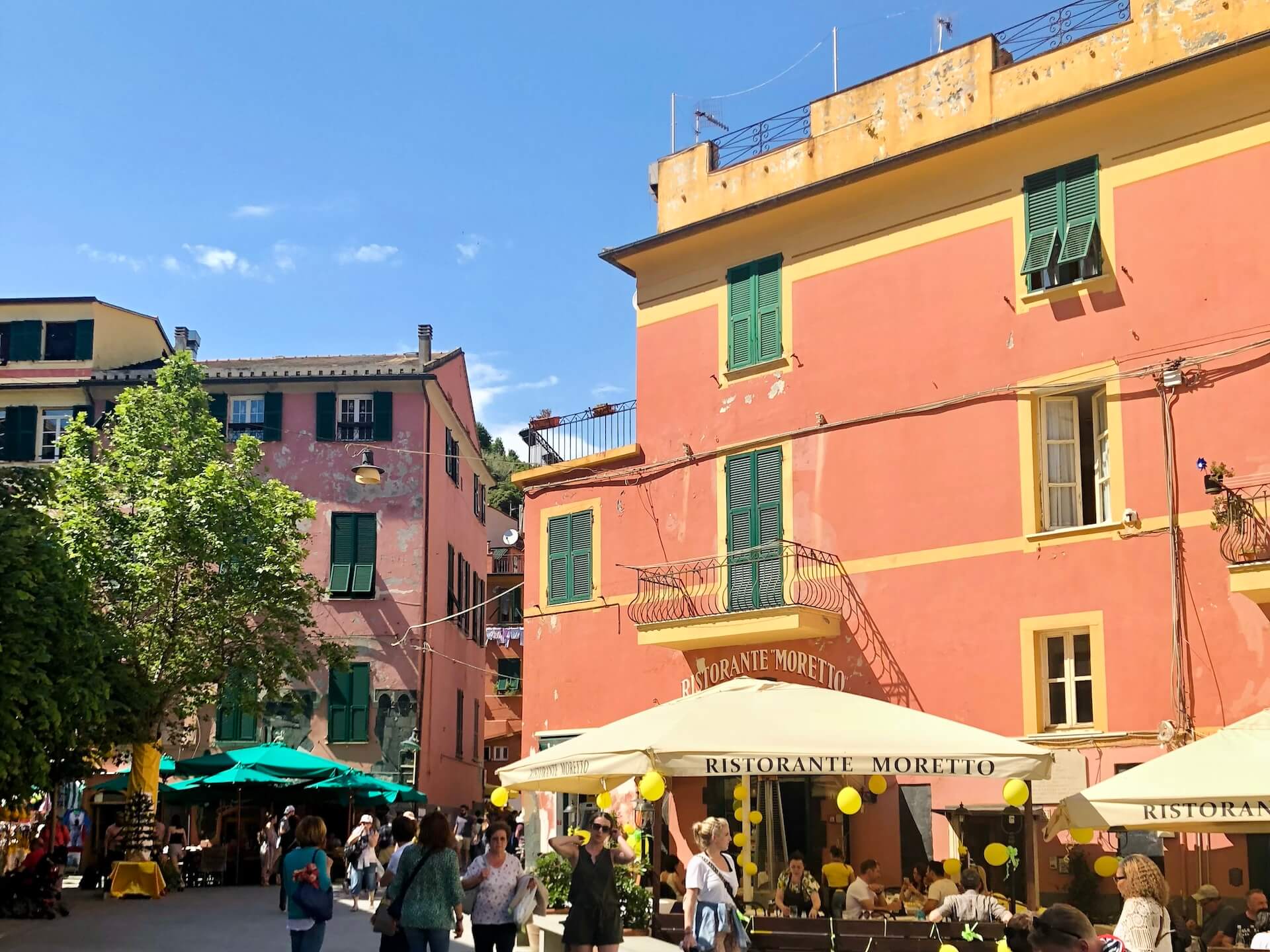
Portovenere and the Cinque Terre exude the essence of Italian Riviera charm.
Though I know I’ve complained about the tourists crowding the ferries, trains, and narrow streets of these tucked-away towns, I know I count as one of those same tourists. Who wouldn’t want to visit these iconic Italian coastal villages?
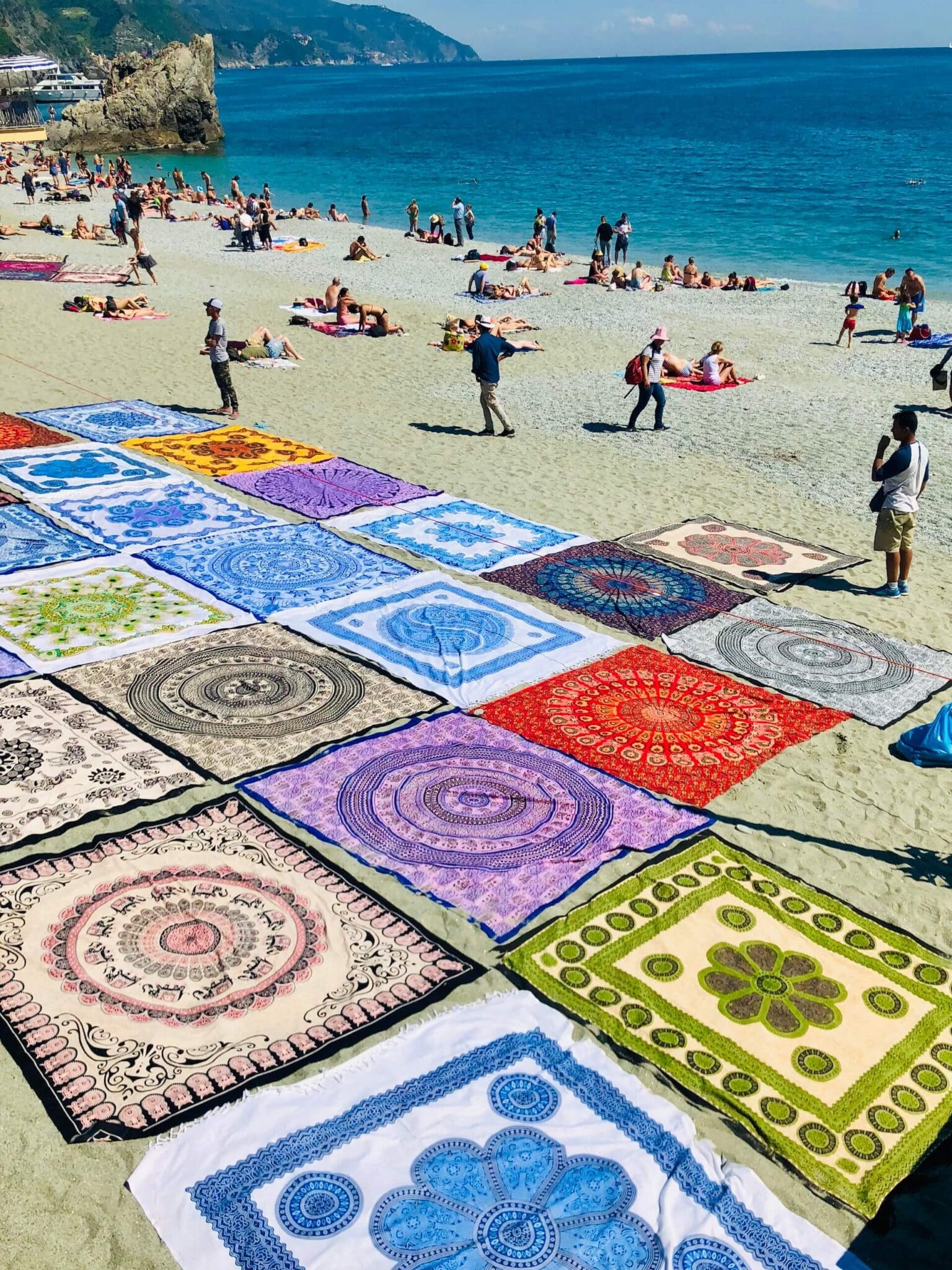
But, this stretch of the Ligurian Coast lives up to the hype and the pictures and is quite literally a slice of heaven (drizzled with pesto, of course).
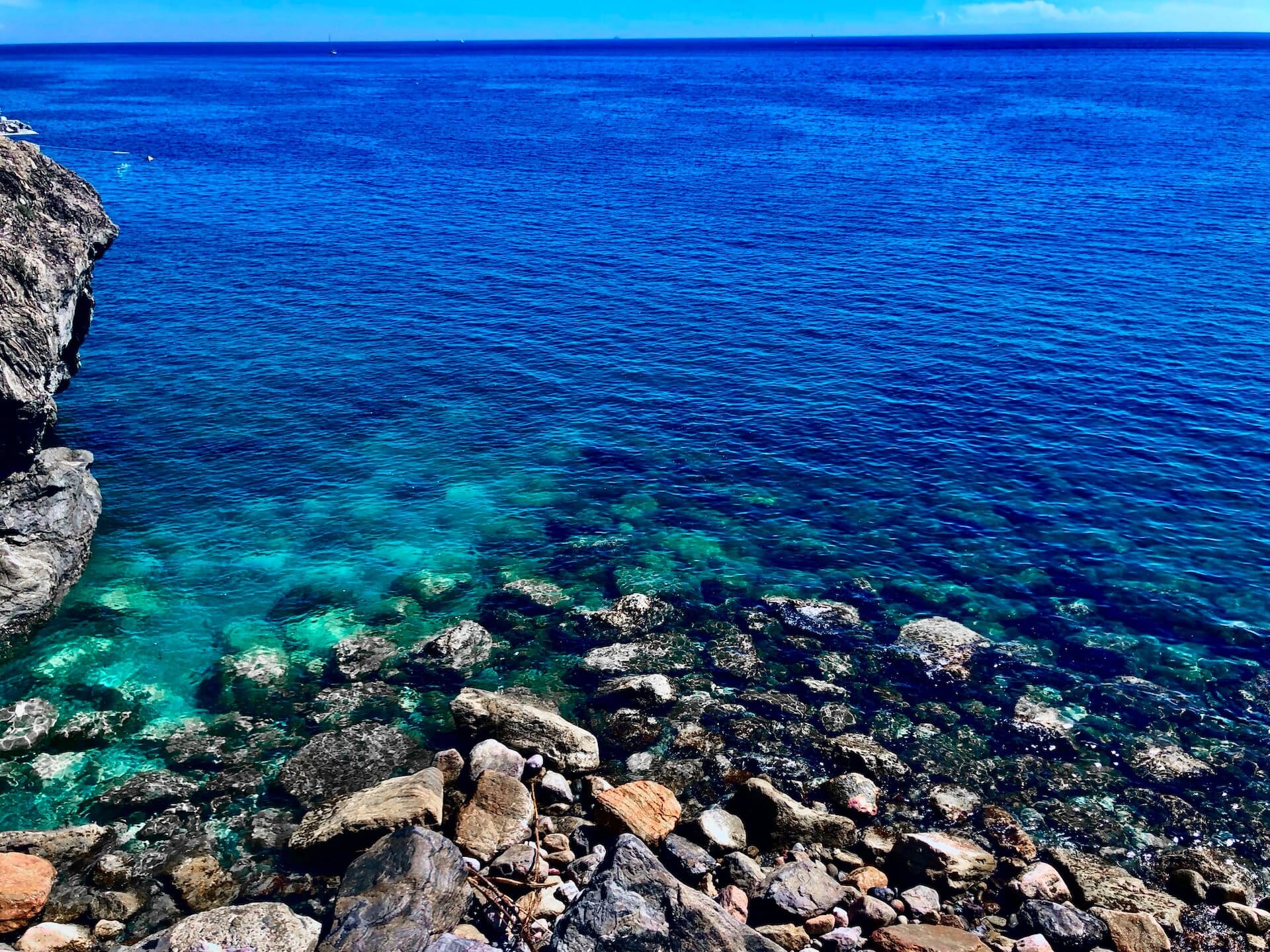
Planning more travel to Italy? Check out these additional Travel Guides!